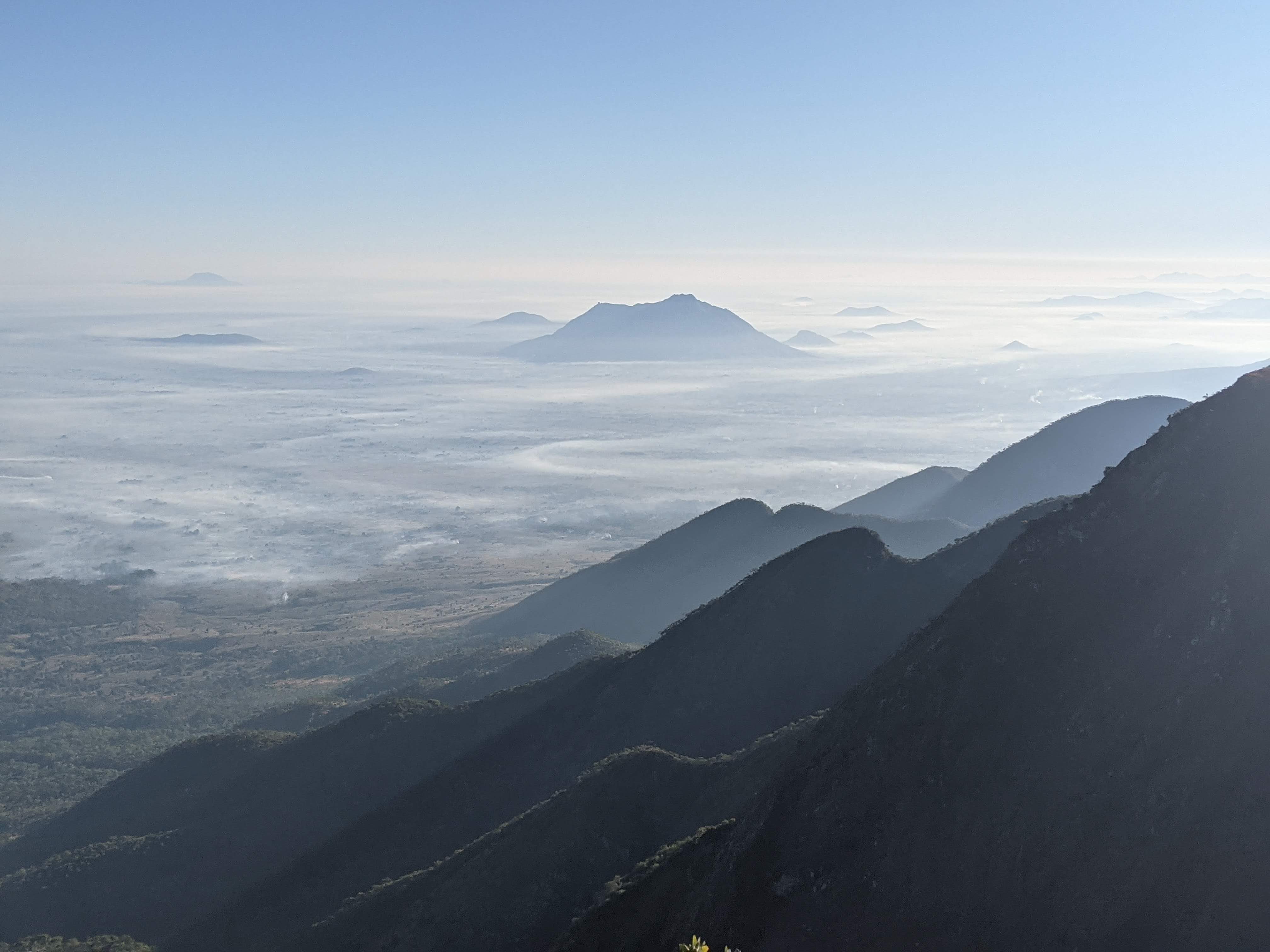
This past weekend I finally returned to Mulanje. There are many wonderful activities and places in Malawi, but hiking on Mulanje Mountain, 1 ½ hours from Blantyre, is one of my favorites. A mixture of personal and professional obligations kept me away for 3 years. Not making the time to visit a place I love is ridiculous.
When the Mountain Club of Malawi advertised a group trip to the mountain, I signed up. Stargazing was the scheduled highlight. The organizer, an astronomy enthusiast, promised to bring up his large telescope. If the night was cloudless, we might see, in addition to the Milky Way, the rings of Saturn and moons of Jupiter.
Mulanje is an inselberg, a geologic formation (rock, mountain) that arises abruptly from the flat surrounding plain. The base of Mulanje Mountain lies at an altitude of 650 meters. There are multiple paths leading up to the mountain’s plateau, 1200 meters higher. From the plateau, beautiful peaks reach towards the sky. Sapitwa (3002 meters), part of the Mulanje inselberg, is the highest spot in Malawi. For hikers, there are 10 huts dotting the plateau. Our destination for the weekend was Thuchila Hut, built in 1901 and famed for its sunset views.
I went with my friends Karen and Peter, their young daughter Mia, and Romy, a visiting Dutch nurse. Saturday morning, we drove out early from Blantyre and started up. It was warm at the bottom and, climbing the Lukulezi Path, we sweated heavily for the ascent’s first 3 hours. Peter carried Mia on his back, constantly singing and talking to her. As we ascended, a slow parade of women passed us heading down, each carrying bundles of 2-3 inch diameter, 6 foot long tree limbs on their heads. Bound for the plains below, the wood would be burned to cook dinner, sold in the market, or perhaps turned into charcoal. Passing several dozens of these wood carriers, I was saddened.
When I first came to Malawi in 2007, Mulanje’s plateau was thick with old growth cedar. Tree trunks 4 feet in diameter were a common sight. Walking through the cedar forests was shady, silent, and beautiful. In the subsequent years, visiting Mulanje, I watched all of these giant trees removed. In the early years they were felled manually by groups of two men, likely spending days to cut through a tree using a nine foot saw. The felled giant was then cut it into roughhewn planks small enough to be carried on someone’s head the 1200 meters down to the bottom. As the years went on, the rhythm of manual sawing was replaced by the sound of machines, powered by fuel carried up on women’s heads, and ending with smoothly cut lumber. All of this was illegal, but no one stopped it from happening. Six years ago, I was up on the mountain and the machine sounds from the logging started early in the morning and lasted continuously until night. I thought: if the Malawians do not care about this mountain, why should I? I could not stomach hearing the destruction of this beautiful natural resource any longer. I was not coming back.
Though saddened by Mulanje’s forests fate, I gained an understanding of why this has happened.
For three years I kept my promise. Perhaps like childbirth, though, a few years make one forget the pain. Mulanje called. The industrial loggers were gone. All of the old growth cedar was, too.
Sweating, my hiking group was the first to arrive at the hut. Mia was happy to get out of her carrier and Peter was relieved to have finished this challenging task. We dropped our backpacks and relaxed, taking in the beauty around us. The famous sunset point did not disappoint and prompted dozens of photos. There is little ambient light on Mulanje and the stars are bright shortly after sunset. As the skies darkened, it took little time for the Milky Way to appear. After dinner our trip organizer, Marc Henrion, gave a short lecture about the optics of telescopes and the types of celestial objects we might see that night. We needed to stay up until 11:30 p.m. to view the planets. Though rising above the horizon much earlier, they had to surmount the surrounding peaks to be seen.
They did not disappoint. With Marc’s telescope, Saturn’s rings were easily visible. We saw 4 of Jupiter’s 79 moons. The tail of Scorpio held the center of our galaxy. Above us arced the Milky Way, traversing the sky. I went to bed tired and having seen many of these things for the first time in my life.
After a deep night’s sleep, I woke early and took a 10 minute walk to the sunset viewpoint. There I found Chinga, one of only two black Malawians on the trip. I talked to him about Mulanje’s logging and asked him if he could provide local insight into this tragedy. He shared my wish to preserve the natural beauty of the mountain, but explained that to poor Malawians, the mountain’s unique geology and old growth forests meant only one thing, a way to feed their families. Whether carrying down tree limbs on their heads to create a fire to cook tonight’s dinner, or providing the labor to efficiently run a mechanized logging operation, most Malawians viewed Mulanje as a resource, a tool. Natural preservation was a luxury. These people needed to eat.
Of course, reconciling forest conservation and logging is not unique to Malawi. This debate goes on worldwide, including in the USA. I have, however, never viewed this debate with my own eyes. Seeing it myself made me think about the debate more deeply. At least the Malawians currently carrying down tree limbs are using the timber for cooking. The old growth cedar that was once thick on the mountain is now lining closets on other continents. It is a tragedy but an understandable one.
Taken together the weekend was terrific. I returned to a no-more-old-growth-cedar but still beautiful Mulanje. I spent time with old friends and made new ones. I was able to stand under the arc of the Milky Way, awed at Earth’s small place in the universe. Though saddened by Mulanje’s forests fate, I gained an understanding of why this has happened. Wiser people than me have said: “Understanding is the first step to acceptance, and only with acceptance can there be recovery.”





